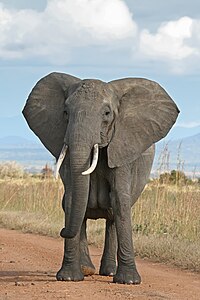
Photo from wikipedia
Abstract Tusk fractures in Asian (Elephas maximus) and African elephants (Loxodonta africana) can result in damage to the distal end or to longitudinal cracks, potentially progressing to pulpitis. With pulp… Click to show full abstract
Abstract Tusk fractures in Asian (Elephas maximus) and African elephants (Loxodonta africana) can result in damage to the distal end or to longitudinal cracks, potentially progressing to pulpitis. With pulp exposure, endodontic therapy is the treatment of choice, but conservative therapy has sufficed for some elephants. This manuscript describes the use of composite materials as a component of tusk fracture management. A 7-yr-old male Asian elephant fractured the distal end of both tusks with pulp exposure in one. Capping of each tusk with a Kevlar/fiberglass composite prevented further damage, and a modification allowed care of the exposed pulp tissue. A 34-yr-old male African elephant with a longitudinal crack received a carbon fiber/fiberglass composite circumferential wrap to potentially stabilize the crack. Compression of the crack was achieved, but follow-up was truncated due to bacterial pulpitis. Both cases show that composite material allows for lightweight, durable management of tusk fractures with continued radiographic monitoring.
Journal Title: Journal of Zoo and Wildlife Medicine
Year Published: 2017
Link to full text (if available)
Share on Social Media: Sign Up to like & get
recommendations!